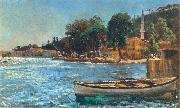Wholesale Oil Painting No Minimum |
|||||||||||
|
|
|||||||||||

|
|||||||||||
|
|
|
||||||||
Jan MatejkoPolish Painter, 1838-1893 He studied from 1852 to 1858 at the School of Fine Arts in Krakew and, during this time, started exhibiting historical paintings with the Society of Friends of the Fine Arts there (e.g. Sigismund I Bestowing Nobility on the Professors of the University of Krakew in 1535 (1858; Krakew, Jagiellonian U., Mus. F.A.). After studying in Munich (1859) under the history painter Hermann Anschetz (1802-80) and then briefly and less successfully in Vienna, Matejko returned to Krak?w, where he was based for the rest of his life. In 1860 Matejko issued an illustrated album, Ubiory w Polsce (later editions 1875 and 1901), a project reflecting his intense interest in historical records of all kinds and his desire to promote such interest among the Polish people in an effort to intensify their patriotic feelings. This role first became widely associated with Matejko with his painting of Stanczyk (1862; Warsaw, N. Mus.), the court jester to King Sigismund I (1437-1548), to whom Matejko gave his own features. The jester is presented as a symbol of the nation's conscience |
||||||||
|
|
||||||||
Widok Bebeku kolo Konstantynopola,
Widok Bebeku kolo Konstantynopola, Painting ID:: 67709 |
Widok Bebeku koło Konstantynopola, en: View of Bebek near Constantinople, oil on canvas, 31.5x61x7, Art Gallery in Lviv Widok Bebeku koło Konstantynopola, en: View of Bebek near Constantinople, oil on canvas, 31.5x61x7, Art Gallery in Lviv |
|||||||
|
CONTACT US |

